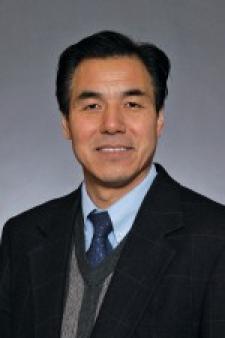Watershed hydrology: advances, challenges and opportunities
By Olga Bonfiglio
College of Arts and Sciences staff writer
“Water is essential to all development goals and ecosystem services,” says Dr. Chansheng He, professor of geography and a watershed hydrology specialist. “Every person must have access to enough water at an affordable cost. This is water security, which leads to a clean, healthy and productive life while ensuring the environment is protected and enhanced.” He presented on "Recent Developments in Watershed Hydrological Research and Future Directions" as part of the Spring 2015 Lyceum Lecture Series sponsored by the Lee honors College.
But water is becoming more difficult to access today because of severe droughts, depleted supplies of groundwater and extreme weather events. In fact, the World Economic Forum said in 2013 that over the next 10 years the water supply crisis will be among the top five crises in the world.
On Feb. 25, 2016, India’s capital was thrown into disarray as 10 million of its people had no access to running water. Droughts and desertification are increasing in northwest China. In some places in Africa, water most often comes from open holes dug in the sand of dry riverbeds, and it is usually contaminated. Over the past five years California has faced record-breaking drought with 41 percent of the state experiencing “exceptional drought.”
Many problems with water are due to natural causes and climate change, but other problems are manmade, like the Elk River chemical spill in Charleston, West Virginia on January 9, 2014, where crude 4-methylcyclohexanemethanol (MCHM) was released from a Freedom Industries facility into the river. Three hundred thousand people were without water. On August 2-4, 2014, in Toledo, Ohio, toxic algal blooms were to blame for the water being shut off for 500,000 people. In Flint, Michigan, people lost their access to water because of high levels of lead and high levels of total trihalomethanes (TTHM), a byproduct of the large amount of chlorine needed to kill off bacteria in the river water. Health and piping issues were the culprits in Flint, but the lead water pipeline system all over the country would need to be replaced at the cost of $1 trillion, according to the American Society of Civil Engineers.
There have been many advances in watershed hydrology that allow scientists to measure precipitation, river discharge, evapotranspiration, groundwater storage, snow pack, soil moisture, surface water storage. These advancements enable scientists to construct models to answer questions like:
- How much water is available in the aquifer, watershed, reservoir, lake or wetland?
- How does the distribution of water change over both space and time in a watershed?
- Will there be enough water available to meet the increasing demands for domestic, irrigation, and industrial supplies and ecosystem services?
- What societal incentives, programs, and policies need to be implemented to ensure the sustainable use of water resources?
He illustrated how climate, hydrology, ecosystem services and water use are connected by the impacts of climate change at the watershed scale and the spatial variability of water uses. These impacts affect water transfer and diversions, redistribution and ecosystem services, which in turn affect agriculture in terms of crop productivity, irrigation and nutrient availability. For people, it means not only access to water but food.
Over the past decades, said He, there has been much progress in understanding our water resources, however, there remains an urgent need for long term, continuous, high quality, and better spatial coverage as well as multiple scale in situ observation datasets of meteorology, soil, hydrology, ecology, economics, and water use. Interdisciplinary collaboration is absolutely essential for a bigger and clearer picture of what is going on with the world’s water resources so that solutions can be proposed and acted on. Finally, integrated models are needed to see where we are headed and how we might change.
“By 2035, 3.5 billion people will face water shortages,” said He. “If the problem is getting worse, we need to do things differently. However, we’re going in the right direction in our research and management of water resources. Researchers are working together. But water resources are dependent on the management of our resources. When we bring people into the center of our agenda, there is hope that things can change.”


